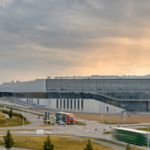Construction of railways
Types of track
The railway track, also known as the ‘permanent way’, is the long horizontal structure that provides trains with a surface for wheels to roll upon.
Traditional track
The most common type of track used around the world is ‘flat bottom’ steel rails supported on sleepers made of timber or pre-stressed concrete.
Typically, tracks are laid on a bed of stone track ballast which is supported by prepared earthworks, known as the track formation.
Ballast consists of crushed stone and is used to uniformly distribute loads from the sleepers to the formation. Ballast also helps with stabilisation, drainage and prevents the sleepers from moving. It is typically laid to a depth of between 225-300 mm, filled to the top of the sleepers and beyond the ends of the sleeper by around 250-500 mm.
The track formation consists of a subgrade and blanket – a layer of sand or stone dust in impervious plastic. The blanket restricts the upward movement of wet clay or silt. Additional waterproofing is provided if deemed necessary. The subgrade layer is slightly sloped at the sides to help water drainage. Water is channelled away by ditch or other type of drain.
In order to prevent soil and water from ‘spoiling’ the ballast, some railways can use asphalt pavement below the ballast, which helps to stabilise it. Where track is to be laid over permafrost, measures such as transverse pipes of cold air can be laid through the subgrade to prevent melting.
Types of rail
Modern rail typically uses hot-rolled steel with a profile similar to that of a rounded I-beam. Because of the high stresses to which they are exposed, rails must be manufactured using very high-quality steel alloy. Rail is graded by weight over a standard length, and the train weight and speed capacity is dependent on the strength of the rails.
In addition to flat-bottom rail, other rail profiles include:
- Bullhead rail.
- Grooved rail.
- Bridge rail (inverted U-shape).
- Barlow rail (inverted V-shape).
Flat-bottom rail is the most commonly used due to its stiffness, greater stability and reduced maintenance requirements. However, bullhead rails are easy to fix and unfix to sleepers, making them useful in applications that necessitate frequent replacement.
As rails are produced in fixed lengths (in the UK, usually around 20 m), they must be joined end-to-end to create a surface that is continuous. The main ways in which this can be done are:



